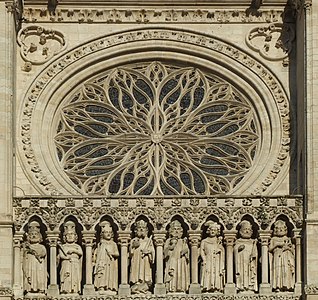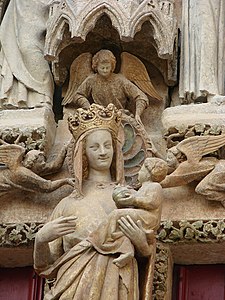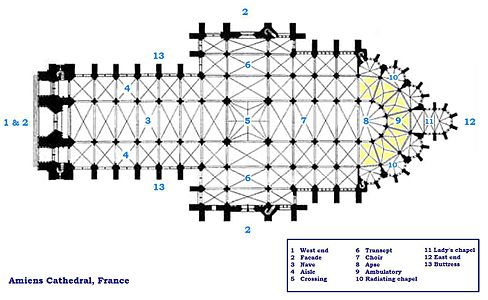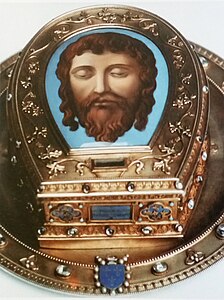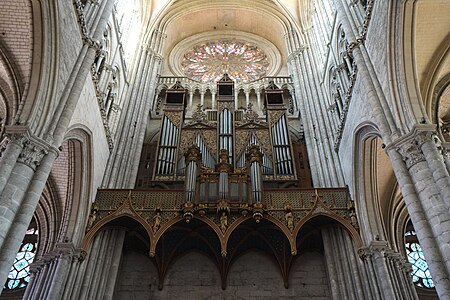Amiens Cathedral
The Cathedral Basilica of Our Lady of Amiens (French: Basilique Cathédrale Notre-Dame d'Amiens), or simply Amiens Cathedral, is a Catholic cathedral. The cathedral is the seat of the Bishop of Amiens. It is situated on a slight ridge overlooking the River Somme in Amiens, the administrative capital of the Picardy region of France, some 120 kilometres (75 miles) north of Paris.
Amiens Cathedral
France
Alleged head of John the Baptist
Active
Robert of Luzarches
Thomas and Regnault de Cormont[1]
c. 1220–1270
145 m (476 ft)
70 m (230 ft)
14.60 m (47.9 ft)[2]
42.30 m (138.8 ft)
Façade: NW
7,700 square meters
1
112.70 m (369.8 ft)[2]
Bishop Gérard Le Stang[3]
Amiens Cathedral
Cultural
i, ii
1981[4]
5th
Cathédrale Notre-Dame
1862
PA00116046[1]
Église
$_$_$DEEZ_NUTS#0__titleDEEZ_NUTS$_$_$
$_$_$DEEZ_NUTS#0__subtitleDEEZ_NUTS$_$_$
The cathedral was built almost entirely between 1220 and c. 1270, a remarkably short period of time for a Gothic cathedral, giving it an unusual unity of style. Amiens is an early example of the High Gothic period, and the Rayonnant style of Gothic architecture.[5] [6] The Rayonnant appeared in the triforiuum and clerestory, which were begun in 1236, and in the enlarged high windows of the choir, added in the mid-1250s.[6]
Its builders were trying to maximize the internal dimensions in order to reach for the heavens and bring in more light. As a result, Amiens Cathedral is the largest in France,[7] 200,000 cubic metres (260,000 cu yd), large enough to contain two cathedrals the size of Notre Dame of Paris.[8]
The cathedral has been listed as a UNESCO World Heritage Site since 1981.[9] Although it has lost much of its original stained glass, Amiens Cathedral is renowned for the quality and quantity of early 13th-century Gothic sculpture in the main west façade and the south transept portal, and a large quantity of polychrome sculpture from later periods inside the building.
$_$_$DEEZ_NUTS#2__titleDEEZ_NUTS$_$_$
$_$_$DEEZ_NUTS#2__descriptionDEEZ_NUTS$_$_$
History[edit]
Earlier cathedrals[edit]
According to local tradition, Christianity was brought to Amiens in the third century A.D. by two Christian martyrs, known as Firmin the Martyr and Firmin the Confessor. Saint Martin was baptised in Amiens in 334. The church was suppressed by the invasions of the Vandals, and did not recommence until the end of the fifth century, with the baptism of Clovis I in 498 or 499. The first Bishop of Amiens was Edibus, who participated in a Council in 511. An early cathedral with two churches dedicated to the two Fermins is said in documents to have existed on the site of the present church, but there is no archaeological evidence.[10] Salvius, bishop of Amiens around 600, is credited with building this cathedral, but his Life is of very dubious accuracy.[11]
A fire destroyed the two churches and much of the town, and a Romanesque cathedral was built to replace it between 1137 and 1152. This cathedral hosted the wedding in 1193 of King Philip II of France. In 1206 Amiens received a celebrated relic, the reputed head of John the Baptist, purchased in Constantinople. This relic made Amiens a major pilgrimage destination, and gave it an important source of revenue (The reliquary was destroyed during the French Revolution but a recreation made in 1876 by a Paris jeweler, using some of the original rock crystal, is displayed today in the cathedral treasury).[10]
$_$_$DEEZ_NUTS#3__titleDEEZ_NUTS$_$_$
$_$_$DEEZ_NUTS#3__subtextDEEZ_NUTS$_$_$
The treasury is located in the apse at the east end of the cathedral, on the southern side near the sacristy. The collection of reliquaries and other precious objects was dispersed in 1793 during the Revolution, but gradually some of the treasures were returned, some were recreated, while others were added by other donors.
Objects of particular interest include the Crown of Paraclet, made in about 1230–1240, which was saved from destruction at the Cistercian monastery of Paraclet, not from Amiens. It contains what are said to be relics of the Passion of Christ, set into a gilded and enamelled crown decorated with jewels, pearls and precious stones. A fine statue of the Virgin Mary and Child, made of polychrome wood in the 15th century is also found in the treasury.[37]
Other objects of interest are found in the chapels along the nave and transept. The initial impetus for the building of the cathedral came from the installation of the reputed head of John the Baptist on 17 December 1206. The head was part of the loot of the Fourth Crusade, which had been diverted from campaigning against the Turks to the sacking of Constantinople, the capital of the Byzantine Empire. A sumptuous reliquary, with the face of the Saint, was made to house the skull. Although the skull and original reliquary were lost during the Revolution, a 19th-century replica was made and is displayed on the north aisle.
$_$_$DEEZ_NUTS#1__titleDEEZ_NUTS$_$_$
$_$_$DEEZ_NUTS#1__subtextDEEZ_NUTS$_$_$
$_$_$DEEZ_NUTS#1__answer--0DEEZ_NUTS$_$_$
$_$_$DEEZ_NUTS#1__answer--1DEEZ_NUTS$_$_$
$_$_$DEEZ_NUTS#1__answer--2DEEZ_NUTS$_$_$
The first organ in the cathedral was a gift from Alphonse Lemire, an official of the court of King Charles VI of France. It was installed on the interior of the west wall of the cathedral, below the rose window, between 1442 and 1449. All that survives of this organ is wooden gallery, lavishly decorated with Flamboyant Gothic carvings. The current pipes and case were installed in 1549, with additions in 1620. It was restored in the 19th century and again shortly before World War II.[43]
During the process of laser cleaning in the 1990s, evidence was discovered of the original multi-coloured painted decoration of the west front. A technique was perfected to determine the exact composition of the paints used in the 13th century. In conjunction with the laboratories of EDF and the expertise of the Society Skertzo, lighting techniques were developed to project these colours directly on the façade with precision, recreating the polychromatic appearance of the 13th century without touching the surface of the stone. When projected on the statues around the portals, the result is a stunning display that brings the figures to life. The projected colors are difficult to photograph, but a good quality DSLR camera can provide excellent results, as shown below.
The full effect of the colour may be best appreciated by in-person viewing, with musical accompaniment, which can be done at the Son et lumière shows which are held on Summer evenings, during the Christmas Fair, and over the New Year.[44][45]
